The following is excerpted from "New Traditions: The Cottage Community," in Early Views: Historical Vignettes of Sitka National Historical Park, by Kristen Griffin, National Park Service Report, 2000.
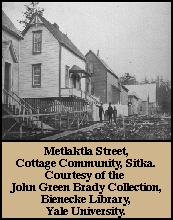 The founders of the Cottage Community were the first generation of Native students to receive a mission education; young adults who came of age in a period of intense cultural change and faced the challenge of building a way of life that was dramatically different from their parents. Many emerged as leaders whose actions still influence Native politics today.
The founders of the Cottage Community were the first generation of Native students to receive a mission education; young adults who came of age in a period of intense cultural change and faced the challenge of building a way of life that was dramatically different from their parents. Many emerged as leaders whose actions still influence Native politics today.
Residents of this community also established a tradition of close involvement with the Park. Like a community commons, the Park in some ways was an extension of the community.
The Community's roots lie in the earliest days of Sitka's Presbyterian mission. Begun in 1878, the mission's goal of assimilating Native youth through formal education, industrial training, religious instruction and isolation from traditional language and culture gained momentum in the 1880s. By 1884, the mission was boarding both male and female students at the site of present day Sheldon Jackson College. A major concern of the missionaries was finding a way to insure that once separated from traditional culture, students would not return to village life. One approach was to create a mission-sponsored model residential community for graduates. With Sheldon Jackson backing the Sitka model cottage project, funds were quickly obtained for three homes and the seeds of a community were sown.
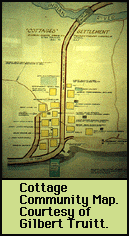 The chosen site for the project was the extreme eastern edge of the mission property, a location physically set apart from the village and the rest of the town. Although the land was part of the mission tract, it also fell within the traditional territory of the Kiks.ádi clan. Money to build the homes was provided to selected married or soon-to-be married students through a revolving loan fund. Although residents repaid the loans, the mission intended to maintain some control over the lives of residents. Residents agreed to keep the Sabbath, provide a school education for their children, maintain public health, abstain from alcohol and gambling, avoid "heathen" festivities and customs, and agree to keep the property in the hands of people who subscribe to the stated rules.
The chosen site for the project was the extreme eastern edge of the mission property, a location physically set apart from the village and the rest of the town. Although the land was part of the mission tract, it also fell within the traditional territory of the Kiks.ádi clan. Money to build the homes was provided to selected married or soon-to-be married students through a revolving loan fund. Although residents repaid the loans, the mission intended to maintain some control over the lives of residents. Residents agreed to keep the Sabbath, provide a school education for their children, maintain public health, abstain from alcohol and gambling, avoid "heathen" festivities and customs, and agree to keep the property in the hands of people who subscribe to the stated rules.
There was no need to hire workers to build the homes. Most Training School graduates were skilled carpenters who had practiced trades like furniture building and construction from the early grades on. The first year, three cottages were completed. They were typical small homes, well-built and uniform in appearance: "The cottages are 24 feet square and one and a half stories high. Each has a living room, kitchen, pantry and wood-house on the first floor and two bedrooms and a closet in the half-story or attic. The students are expected to repay the loan at a rate of $50 per year." (Home Mission Monthly, December 1888).
By 1895, the number of cottages had increased to eight. At its peak, homes occupied roughly sixteen lots bounded by Kelly Street and Metlakatla Street, which at the time crossed Indian River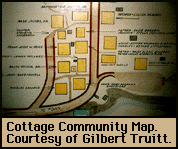 and provided access to Jamestown Bay and beyond. A series of simple boardwalks ran in front of some of the homes and at some point streetlights were added along Metlakatla Street. Cottage resident Cyrus Peck noted that the streets were named for two men who were important in the community's development. Metlakatla Street was named for Native leader Peter Simpson, a Tsimshian from Metlakatla, Alaska. Kelly Street honored Superintendent Kelly of the Sheldon Jackson School; he was a strict disciplinarian who ruled with an "iron hand," but was also much respected (C.Peck Interview, 1991, Southeast Alaska Indian Cultural Center, #VT-91-1-B).
and provided access to Jamestown Bay and beyond. A series of simple boardwalks ran in front of some of the homes and at some point streetlights were added along Metlakatla Street. Cottage resident Cyrus Peck noted that the streets were named for two men who were important in the community's development. Metlakatla Street was named for Native leader Peter Simpson, a Tsimshian from Metlakatla, Alaska. Kelly Street honored Superintendent Kelly of the Sheldon Jackson School; he was a strict disciplinarian who ruled with an "iron hand," but was also much respected (C.Peck Interview, 1991, Southeast Alaska Indian Cultural Center, #VT-91-1-B).
What began as a street of individual homes soon grew into something more. As the homes took shape, so did a distinct community with a strong identity that was recognized throughout the town.
Although the intended purpose of the Cottages was to encourage a break with old ways, several sources have suggested that all traditions did not necessarily disappear. Like the Native residents of the village, Cottage residents continued to rely on the lower Indian River area as a close, convenient, year-round source of traditional foods, including salmon, clams, deer, food and medicinal plants, and berries. Others have pointed out that families with Kiks.ádi clan connections were well represented in the Cottages, which could have been a way of preserving ancestral ties to the Indian River area (Thorton, Thomas F. with Fred Hope.Traditional Tlingit Use of Sitka National Historical Park. Report prepared under contract for the National Park Service, 1998).
Most early Cottage residents made their living in trades that seemed to combine traditional Tlingit skills with those learned at Sheldon Jackson School. These included fishing, boat building, carpentry, selling crafts, furs and other handwork. A number of these industries were centered in and around the Park. Cottager Peter Simpson's boat shop located at the seaward end of Metlakatla Street was a Cottage community landmark. Many adults who grew up in the Cottages remember playing there as children (Thorton, 1998. F. Hope Interview, Project Jukebox). Cottage residents applied their woodworking skills when, in 1906, E.W. Merrill sought Native carvers to help prepare the collection of totem poles returning from exhibition at St. Louis and Portland for placement in the Park (Gmelch, Sharon. History of Photography, V.19, No. 2, 1995).
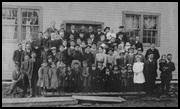 As the community grew, its identity was reinforced by a number of distinctly community-level actions that included building a communal gathering place (Cottage Hall), hosting social events for the broader community, and forming community-based organizations. Since the community was organized around the Presbyterian Church, Cottage residents were involved in Church-related organizations, like the Christian Endeavor Society, the New Covenant League, and the Cottage Women's Missionary Society (The Thlingit, March 1909). The community placed high value on musical ability; it fielded a concert band, an orchestra, and vocal groups. Cottage Hall was a central gathering place. Thanksgiving feasts were held there. It was the backdrop for formal group photographs. The Cottage Band practiced there. It was the setting for entertainment, such as concerts, literary readings, and skits. According to educator and historian Gilbert Truitt, Cottage Hall also was the first place basketball was played in Sitka.
As the community grew, its identity was reinforced by a number of distinctly community-level actions that included building a communal gathering place (Cottage Hall), hosting social events for the broader community, and forming community-based organizations. Since the community was organized around the Presbyterian Church, Cottage residents were involved in Church-related organizations, like the Christian Endeavor Society, the New Covenant League, and the Cottage Women's Missionary Society (The Thlingit, March 1909). The community placed high value on musical ability; it fielded a concert band, an orchestra, and vocal groups. Cottage Hall was a central gathering place. Thanksgiving feasts were held there. It was the backdrop for formal group photographs. The Cottage Band practiced there. It was the setting for entertainment, such as concerts, literary readings, and skits. According to educator and historian Gilbert Truitt, Cottage Hall also was the first place basketball was played in Sitka.
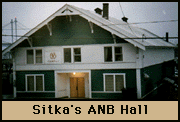 Cottage residents were also involved in the 1912 founding of the Alaska Native Brotherhood (ANB). The objectives that galvanized the new social and political organization, especially education, equality, opportunity and citizenship, were issues important to Cottage residents. Within a short time, the community and the ANB were closely associated. In 1914, ANB Camp Number 1 opened the organization's first meeting hall along the waterfront in Sitka's Native village.
Cottage residents were also involved in the 1912 founding of the Alaska Native Brotherhood (ANB). The objectives that galvanized the new social and political organization, especially education, equality, opportunity and citizenship, were issues important to Cottage residents. Within a short time, the community and the ANB were closely associated. In 1914, ANB Camp Number 1 opened the organization's first meeting hall along the waterfront in Sitka's Native village.
The community began to noticeably change in the early 1920s, losing some of its uniformity and connection with the mission. Families in the Cottages were not immune to the problems impacting other Native communities. Some families experienced deaths due to disease and alcohol. Other families chose to move to the village. In time, homes that did not look like the original mission cottage houses began to be built (C. Peck Interview, 1991, Southeast Alaska Indian Cultural Center. #VT-91-1-B). Other changes involved the neighboring park. Over time, the official government presence in the Park grew stronger, an unfamiliar sensation to those who were accustomed to unrestricted access and the slow pace of change in the area (E. Hays interview, Project Jukebox). Between 1955 and 1963, the National Park Service acquired the properties along the Park side of Metlakatla Street and owners were relocated to properties in town. These old homes were demolished, replaced with landscaping, parking, and in 1965 the Park's Visitor Center (Antonson, Joan and William Hanable. Administrative History of Sitka National Historical Park. National Park Service, 1987).
It is not known how many of the homes along Kelly and Metlakatla Streets date to the earliest days of the community. One or two appear similar in outline to the 1880s vintage cottages and others were built around 1910 in a second wave of home building. In spite of these changes, a footprint of a vibrant community remains. At its peak, the homes and streets were alive with a sense of community, music, industry, and an emerging social and political ideal. Its story is one part of the complex picture of cultural change Alaska Natives experienced in the late 19th and early 20th centuries.

